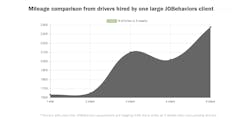Is predictive hiring the cure for trucking’s turnover epidemic?
Even though Class 8 trucks are getting smarter and more technologically advanced every year — such as automatic braking systems to mitigate collisions and transmissions that shift based on GPS data — the way most fleets have found the drivers to operate them have not progressed.
“We've been hiring drivers the same way for the last 25 years: screening drivers based on qualifications, hiring drivers based on qualifications,” said T.J. Graff, director of driver development at TTJ Recruiting. “And we know that that hasn't worked, because we're still maintaining that 75 to 125% driver turnover.”
This lack of innovation is an even more serious problem since COVID-19 leaped onto the dogpile of trucking’s heaviest issues, such as safety, capacity, and driver recruitment and retention. According to the American Transportation Research Institute's (ATRI) 2020 Top Industry Issues list, surveyed motor carriers cited the driver shortage and driver retention as the top two problems.
This year will produce 40% fewer commercial driver’s license holders due to shutdowns at driving schools and DMVs. Drivers are already a scarce resource, with the American Trucking Associations forecasting the current shortage of 80,000 drivers will increase to 100,000 in 2023 and possibly 160,000 by 2028.
That puts the onus on fleets to keep the drivers they have around for the long haul, which as Graff pointed out, has not been a strength. The aggregated turnover average over the past decade falls around 90% for large truckload fleets and near 80% for small fleets.
Graff advocates for fleets to treat recruitment with the same technological savvy as they do every other aspect of the business, to rely on sophisticated data analysis to find the crème de la crème of long haulers. To prevent bad hires and a revolving door policy, Graff strongly believes trucking companies need to leverage predictive hiring.
Through this method, which is used in several fields of employment, the candidate takes an online assessment comprising A/B type questions that are neither right nor wrong, but rather reveal what a driver holds at a premium. Graff uses the truck driver assessment from JOBehaviors, a Seattle-based company with nearly 500,000 drivers in the database.
The assessment takes about 10 minutes and consists of 100 questions. Only the recruiter sees the results. Other transportation-centric assessments include diesel technician, delivery driver, and bus driver.
For example, a candidate may be asked to choose between a behavior statement and a skill statement, such as if it is most important to keep fuel levels high or to arrive at the depot on time. The questions may seem tangential, but the answers overall create an honest portrait of a driver’s core values. The catalyst is the proprietary algorithm operating under preset conditions that analyzes the responses and assigns that person a score or rating. Derived from the behaviors and core competencies of truckers considered to be the top 5% in their profession, the algorithm ranks candidates from one to five stars, five being the best.
Graff, a former Fleet Driver of the Year for Marten Transport and who has driven in Iraq and Afghanistan in the 2000s, scored four stars for driving. He also took one for sales and management and scored five stars. He only received two stars for operations manager, which he said made sense as he had that role briefly as a convoy commander in Iraq, leading other drivers.
“I was lousy at it, I didn't enjoy it, I wasn't well suited for it,” Graff recalled.
“The drivers realized it, too — they were ready to hand me over to the insurgents,” he joked.
Graff acknowledged there might be pushback from certain employees within a company. One former driver currently in a safety role scored only two stars and believed the assessment to be faulty.
Graff followed up asking why he no longer drove, and the safety analyst said he was sick of being out on the road. That is exactly what the assessment screens for: not if the spirit is capable, but if it is willing for long lonely nights on the road and putting up with the demands of the job.
More experience does not always mean a driver is the best candidate. Tulia Tafao, a retired senior chief petty officer in the U.S. Navy and general contractor who got his CDL in 2018, was placed by TTJ Recruiting at Sunset Logistics after only a year of driving. He scored four stars on the assessment and attributed the patience he learned in the Navy, where a hearty helping of “hurry up and wait” is served morning, noon, and night, as a reason for his success.
Tafao also views hauling general freight as a twilight tour while he waits for his wife to retire. He had previously been part of a team, but leaving his life in someone else’s hands didn’t suit him.
“That's why I joined Sunset — to go solo so I can sleep well at night,” Tafao said.
Star performance
“Drivers rated at the highest level act as an effective representative for the employer, maintain self-control in stressful situations, are patient at all times, come to work well-rested, focus on driving at all times, and make every effort to be the best job possible,” explained Mark Tinney, JOBehaviors founder, president and CEO, who estimated the overall cost of keeping driver capacity stable at nearly $9 billion per year.
As for one-stars, Tinney said, “It doesn't mean they have a bad personality, it doesn't mean that they're not intelligent. At the end of the day, it's a very strong indication that they wouldn't be terribly happy over the long term doing this kind of job.”
Tinney stressed that unlike the typical recruiting process that only looks for negatives that would disqualify a candidate, the predictive hiring tool "is really about making a positive identification on a strong match across all of the elements of the job."
Typically, half of the test takers fall in the one and two-star column, and the other half are three, four, or five-star recruits. What the assessment managers do is dig past the technical aptitude a commercial driver license holder may have and uncover their behavioral qualities, which more directly influences performance, productivity, and safety, Tinney said. JOBehaviors attributes at least two-thirds of actions detrimental to the fleet — such as missing shifts, poorly maintaining equipment leading to downtime and repairs, and poor customer interactions — to the bottom third of its drivers.
Graff was quick to mention this is the first step to finding the best driver to fit a carrier’s culture, and the typical screening and application process is still carried out.
Weeding out these less enthusiastic, more accident-prone drivers is really the crux of why to employ predictive hiring, asserted Graff, whereas incentives end up attracting and encouraging both the best and brightest and less desirables.
“We haven't made any headway regarding lowering driver turnover and improving driver retention other than the traditional ways of paying drivers more, providing them with better equipment, being nice to them, and communicating better,” Graff noted. “All of those things are good, but if we just do those things without hiring quality, qualified drivers, we end up with a higher paid, better equipped, home more often, better entertained, lousy driver.”
In short, predictive hiring can help ensure all those enticing benefits are allocated to those who deserve them and will provide the best return on investment by taking care of the trucks, getting in fewer accidents and driving more miles. One East Coast fleet with 1,500 drivers found those who passed the assessment accrued 25% more miles at the five-week mark than those who did not. This logistics company had decided to hire every qualified driver who had taken the assessment, regardless of rank. While someone who scored one star would drive about 1,600 miles, a five-star driver would hit 2,400 miles, a 50% improvement.
“There's so much profitability that can be improved,” Tinney said. “When you start addressing safety, fuel mileage, maintenance, cost, etc., you can now take some of those savings and turn them back into either better starting pay to attract candidates and identify those who are worthy of that increase in pay or benefits.”
Driven by data
The most important question is if JOBehaviors, which has grown 50% annually in the last few years, can improve retention and stop what Tinney calls the turnover “merry-go-round.” Overall, JOBehaviors attested its assessment-approved drivers help clients increase retention by two to three times the industry average.
After 18 months, a FedEx contractor called Fairview Trucking that drew its driver pool entirely from JOBehavior approved candidates, reached 85% retention. The tool was recommended by Protective Insurance, which made JOBehaviors their preferred vendor.
Paper Transport Inc. found drivers hired since using the assessment had 3% better MPG scores, attributed to more thoughtful use of idle time. Since October 2018, Paper Transport has cut turnover by 42% and added more than 150 drivers to a total of more than 900. Turnover now stands at 48% per year. Their driver replacement cost is $10,000 per person, so by using JOBehaviors’ assessment, they lost 300 fewer drivers per year saved $3 million. In 2019 the Wisconsin-based fleet also recorded its safest year ever. The caveat is that hiring for quality over quantity slows the speed of growth.
“We certainly cannot grow as fast as we used to but over the long term we are going to grow more,” said Wes Kornowske, Paper Transport VP of operations.
For Cox Transfer, Inc., a client of TTJ Recruiting, predictive hiring helps the company maintain a profitable level of truck utilization. The fleet of 100 trucks delivers for manufacturers and major retailers and pays fixed weekly salaries to their 90 to 120 drivers. They have no shortage of applicants, but president and owner Mark Voudrie said only 20% are hirable due to the company’s rigorous expectations for excellent drivers. One reason is because of rising insurance costs despite “very few incidents.” Safe drivers keep those premiums from going even higher.
Those aren’t always easy to get in the door. “Finding a skilled driver who is also a good person is difficult,” Voudrie said.
“That's what prevented us from growing in the past is we would get up to 120 to 125 trucks and suddenly have 25 trucks sitting empty, which means we’re going to start losing money,” Voudrie said. “We started the predictive hiring about a year ago and it has really made a big difference for us."
Recruiting is a reciprocal transaction, of which Voudrie is well aware.
“All the predictive hiring does is get us a phone call, he said. “Then we have to have something that the next company is not offering.”
Along with a salary option (only one driver still stayed mileage-based), drivers receive six paid holidays and employment time-based vacation, with 20 days for a decade of service. This also helps attract drivers interested in a long-term commitment.
“Your typical driver couldn’t care less about three years down the road, because their mindset is to jump in 12 months and get another signing bonus,” Voudrie said. “No system is perfect, but knowledge is power. If you have something to offer drives other than a job, then this system will work.”
About the Author
John Hitch
Editor
John Hitch is the editor-in-chief of Fleet Maintenance, providing maintenance management and technicians with the the latest information on the tools and strategies to keep their fleets' commercial vehicles moving. He is based out of Cleveland, Ohio, and was previously senior editor for FleetOwner. He previously wrote about manufacturing and advanced technology for IndustryWeek and New Equipment Digest.


